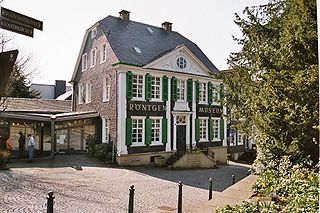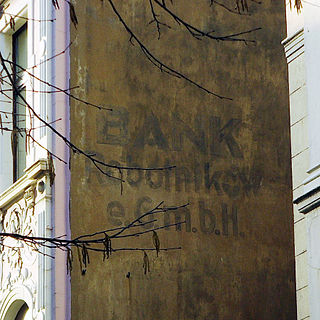
Buchenwald was a Nazi concentration camp established on Ettersberg hill near Weimar, Germany, in July 1937. It was one of the first and the largest of the concentration camps within Germany's 1937 borders. Many actual or suspected communists were among the first internees.

Gelsenkirchen is the 25th most populous city of Germany and the 11th most populous in the state of North Rhine-Westphalia with 262,528 (2016) inhabitants. On the Emscher River, it lies at the centre of the Ruhr, the largest urban area of Germany, of which it is the fifth largest city after Dortmund, Essen, Duisburg and Bochum. The Ruhr is located in the Rhine-Ruhr Metropolitan Region, one of Europe's largest urban areas. Gelsenkirchen is the fifth largest city of Westphalia after Dortmund, Bochum, Bielefeld and Münster, and it is one of the southernmost cities in the Low German dialect area. The city is home to the football club Schalke 04, which is named after Gelsenkirchen-Schalke. The club's current stadium Veltins-Arena, however, is located in Gelsenkirchen-Erle.

Remscheid is a city in North Rhine-Westphalia, Germany. It is, after Wuppertal and Solingen, the third-largest municipality in Bergisches Land, being located on the northern edge of the region, on the south side of the Ruhr area.

Mittelbau-Dora was a Nazi concentration camp located five miles from the town center of Nordhausen in Thuringia, Germany. It was established in late summer 1943 as a subcamp of Buchenwald concentration camp, supplying slave labour from many Eastern countries occupied by Germany, for extending the nearby tunnels in the Kohnstein and for manufacturing the V-2 rocket and the V-1 flying bomb. In the summer of 1944, Mittelbau became an independent concentration camp with numerous subcamps of its own. In 1945, most of the surviving inmates were sent on death marches or crammed in trains of box-cars by the SS. On 11 April 1945, US troops freed the remaining prisoners.

Jülich is a town in the district of Düren, in the federal state of North Rhine-Westphalia, Germany. As a border region between the competing powers in the Lower Rhine and Meuse areas, the town and the Duchy of Jülich played a historic role from the Middle Ages up to the 17th century.

Fröndenberg is a town in the district of Unna, in North Rhine-Westphalia, Germany.

Artern is a town in the Kyffhäuserkreis district, Thuringia, Germany. The former municipalities Heygendorf and Voigtstedt were merged into Artern in January 2019.

Oschatz is a town in the district Nordsachsen, in Saxony, Germany. It is located 60 km east of Leipzig and 60 km west of Dresden.

The Langenstein-Zwieberge was a concentration camp, an under-camp of the Buchenwald concentration camp. More than 7000 prisoners from 23 countries were imprisoned there between April 1944 and April 1945. The camp was situated in the village of Langenstein, Saxony-Anhalt, which has since been absorbed into the town of Halberstadt.

Ruhrpolen is a German umbrella term for the Polish migrants and their descendants who lived in the Ruhr area in western Germany since the 19th century. The Poles migrated to the rapidly industrializing region from Polish-speaking areas of the German Empire.
Emil Carlebach was a Hessian Landtag member, a writer, and a journalist. He was born and died in Frankfurt am Main.

Otto Förschner was a German Schutzstaffel (SS) officer and a Nazi concentration camp commander. After serving with the Waffen-SS on the Eastern Front, Förschner worked as a senior official at the Buchenwald concentration camp (1942-1943) and later served as the commandant of Mittelbau-Dora (1943-1945) and Kaufering (1945). Following the German defeat, he was convicted of war crimes by US occupation authorities at the Dachau trials and was hanged in May 1946.

Wilhelm Simon was a German SS-Hauptscharführer. During World War II he held administrative posts at the concentration camps of Buchenwald and Mittelbau-Dora. He was convicted of war crimes by the United States in 1947.
The following is a timeline of the history of the city of Cologne, Germany.

Subcamps, officially Arbeitslager der Waffen-SS, were outlying detention centres (Haftstätten) that came under the command of a main concentration camps run by the SS in Nazi Germany and German-occupied Europe. The Nazis distinguished between the main camps and the subcamps subordinated to them. Survival conditions in the subcamps were, in many cases, poorer for the prisoners than those in the main camps.

The Ardey Railway is a 38 km long railway line running from Dortmund via Schwerte to Iserlohn in the German state of North Rhine-Westphalia.
The following is a timeline of the history of the city of Essen, Germany.

Ergste is a stadtbezirk of the town of Schwerte in Germany. As of 31 December 2012, Ergste had a population of 7025 inhabitants. It lies south of the river Ruhr near Sauerland. Ergste is twinned with the French commune Allouagne.

Villigst is a Stadtteil (district) of the city Schwerte in North Rhine-Westphalia, Germany. On 31 December 2012, Villigst had a population of 3.309 inhabitants. It lies south of the river Ruhr near Sauerland. It borders on Ergste, another district of Schwerte. On 1 January 1975 Villigst was incorporated into the city Schwerte, before it belonged to Iserlohn.
The following is a timeline of the history of the city of Kassel, Germany.





















